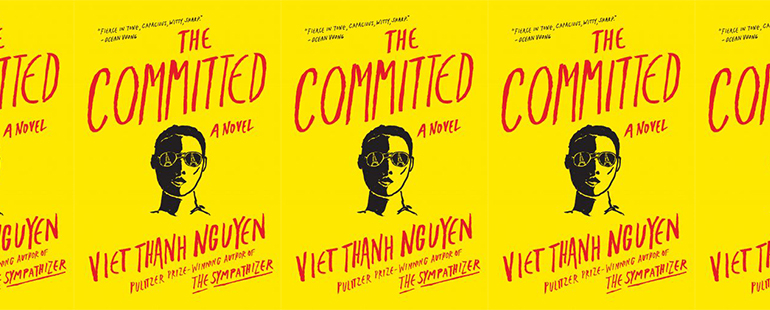The Committed by Viet Thanh Nguyen

The Committed
Viet Thanh Nguyen
Grove Atlantic | March 2, 2021
One man’s murder is another’s revolution. Viet Thanh Nguyen’s new novel The Committed, his sequel to 2015’s The Sympathizer, explores the moral duality of leftist violence in a book that marries thriller and theory, racing the reader through the criminal underworld of Paris before stopping to unpack Frantz Fanon. Using suspense as a vehicle for postcolonial philosophy has a certain logic: what could be more suspenseful, at least for ex-colonies and their diasporas, than the rush towards their own futures? Theory dominates so heavily that reading at times feels more like sitting in a graduate seminar than being swept away in a story. But narrative cannot exist without theory. The stories we tell ourselves take their shape from systems of thought and power. Try to imagine, for example, any rags-to-riches tale without capitalism.
Rags to riches is often the structure of immigrant stories, journeys necessitated by economic struggle or the violence inherent in capitalism. In The Committed, the narrator from The Sympathizer, landing in Paris after a perilous boat journey and a stay in a refugee camp, decides to abandon his communist ideals to focus on his capitalist skills: he becomes a gangster. What begins small—accidental cocaine trafficking, selling hashish to politicians and intellectuals—balloons into a battle between an Asian gang and an Arab one, a scaled-down version of the way that postcolonial people fight each other for ex-colonizers’ leftovers. Even the terms of battle are determined by the West: in one harrowing passage, a North African gangster forces the narrator to play Russian roulette with himself, citing a film about Vietnamese people. That film, of course, is the 1978 American war drama The Deer Hunter, whose fabricated roulette scene continues to define perceptions of Vietnamese depravity.
In such highly-charged scenes, point of view shifts, a revival of a technique from The Sympathizer, in which narration degenerates from first-person singular to dissociated third-person under the pressure of torture and traumatic memory. The Committed further destabilizes perspective, launching with a lyrical first-person plural prologue: “We were the unwanted, the unneeded, and the unseen, invisible to all but ourselves.” This plays to readers both inside and outside the Vietnamese diaspora. For the diaspora, the prologue honors a shared collective memory, a terror looped in the genes of descendants. To non-Vietnamese, the plural voice underlines perceptions of sameness and interchangeability, an inhuman anonymity shown in black-and-white photographs of refugees crowded on fishing boat decks, photos almost always shot from an elevated perspective that makes the subjects appear low and small. The idea of the boat person is part of a long Western cultural project, according to Nguyen’s narrator:
I was not a boat person unless the English Pilgrims who fled religious persecution to come to America on the Mayflower were also boat people. Those refugees just happened to be fortunate that the soon-to-be-hapless natives did not have a camera to record them as the foul-smelling, half-starved, unshaven, and lice-ridden lot that they were. . . . No, the boat people were not human, they did not get the benefit of some romantic painter casting them in oils, standing boldly on the prow of their sinking ships, facing the monstrous elements with the nobility of Greek heroes, enshrined in the Louvre to be admired by tourists and studied by art historians.
The difference between the pilgrim and the boat person, between white and non-white, is enshrined by art and academia, and this duality threads throughout the novel in absurdist puns. The Arab gangsters identify themselves as “butter,” which turns out to be a mishearing of a slang term for North Africans (beurre, Beur). The name of the protagonist’s best friend, Bon, is French for “good”––and also, with the addition of Vietnamese diacritics, “four,” a number symbolizing death. A criminal middle manager (“the typical romantic Vietnamese man: part poet, part playboy, and part gangster”) is called Le Cao Boi, a homonym for Cowboy. This slipperiness, with sounds shifting from one language to the next, extends W. E. B. Du Bois’s double consciousness into a multiple consciousness, one created by colonizations enacted by Americans, French, and others. This multiplicity––also signaled by parts titled “Me,” “Myself,” and the French second-person “Vous” and “Tu”––tangles the linearity of the thriller genre, in which a singular protagonist fights a singular villain. Instead, the ostensible enemy, the head of the rival Arab gang, spontaneously quotes a Fanon text in unison with the narrator, as if they share a postcolonial voice. The protagonist is multiple, like the villain––the colonizer.
The book is also peppered with nods to Vietnamese identity, simultaneously educating the non-Vietnamese reader while winking at the Vietnamese one, too. For occasions ranging from business meetings to bloody shootouts, the gangsters drink cognac, a bottle of which is required on high glass shelves in many nonfictional Vietnamese households. Criminals decompress over episodes of Fantasia, a fictionalized version of the flashy and enormously popular diaspora variety show Paris by Night. And an item popular among immigrants of many backgrounds, the Danish butter cookie tin, appears repeatedly: first, with actual cookies; later, concealing a Walther P38 semiautomatic. It is no accident that these Vietnamese signatures are all, by name or provenance, also European. “After all, even as we criticized the French, were we not drinking their cognac?” the narrator asks. “Oh, quelle contradiction!”
Even for readers without memories of Danish butter cookie tins, The Committed embeds humor accessible to everyone, whether scatological (a continually clogging toilet that requires fixing by the teary-eyed narrator) or sexual (descriptions of men’s private parts).Alongside the suspense of the gangster wars and lyrical dives into the narrator’s memories, these details make the novel’s headier theory easier to digest. Even so, Nguyen does not allow the reader to forget that fiction traffics in truth. Toward the end of the novel, a real photo of a protest appears: theory made real.



